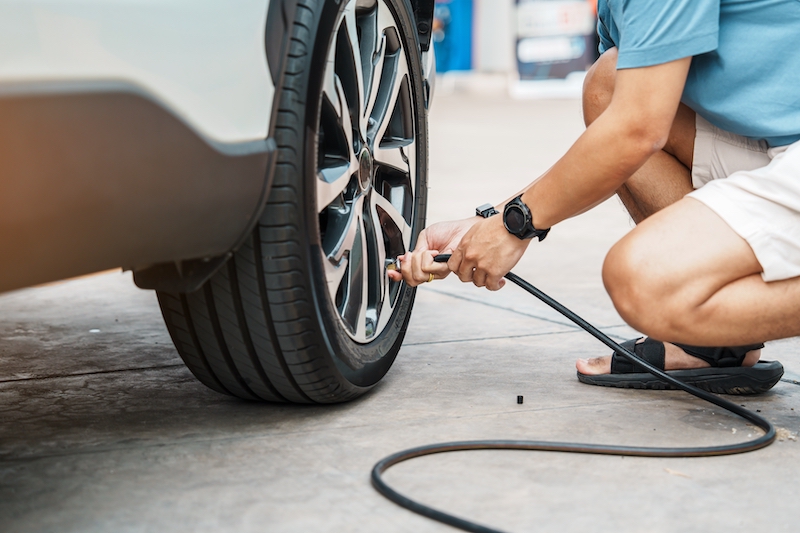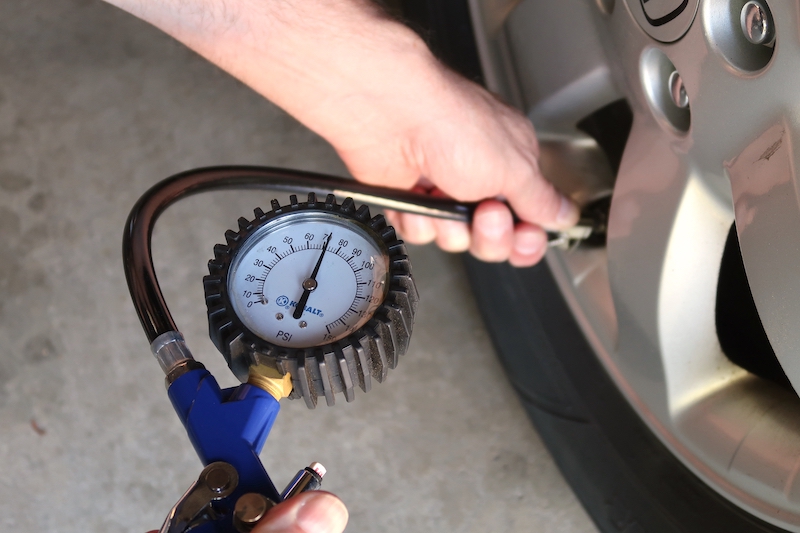Checking your car’s tire pressure is an essential part of preventative car maintenance.
It’s crucial to maintain the manufacturer’s recommended pressure—which you can usually find in your vehicle’s owner’s manual, or on a sticker inside the driver’s side door jamb or glove box door. Improper tire pressure can reduce your car’s fuel efficiency, prematurely wear the tires, reduce braking performance, and increase the risk of tire damage or failure—like a blowout.
While it’s standard for an auto technician to check your car’s tire pressure during a routine maintenance visit, it’s still a good idea to regularly check it yourself (especially during summer and winter) at a gas station air pump—which is usually free to use.
So, how can I check my car’s tire pressure at an air pump?

Roll up your sleeves, take in a deep breath of confidence, and then follow these simple steps:
- Remove the cap from the tire’s valve stem. It’s a small, round cap that unscrews easily. Keep the caps safe and handy, because you’ll need them again later.
- Use the gas station’s air pump gauge to check your tire’s pressure by pressing it onto the valve stem until it reads a pressure.
- Note the pressure reading, measured in psi (pounds per square inch), and compare this number with your car’s recommended tire pressure.
- If the tire pressure is too high, let some air out and recheck it using the gauge.
- If the tire pressure is too low, add air with the gas station’s air pump until it reaches the recommended pressure. Check the pressure again with the gauge to make sure it’s accurate.
- Replace the valve cap securely once the tire pressure is at the recommended level.
- Repeat these steps for all four tires.
These are just general tips, but you can find more information in your vehicle’s owner’s manual about the recommended way to check the tire pressure for your car’s specific year, make, and model.
Keep in mind: It’s most accurate to check your tire pressure when the tires are cool. Try to check the pressure in the morning or after your car has been parked for a few hours. If possible, try to drive only a short distance and avoid high speeds on your way to the gas station to keep the tires as cool as possible for an accurate reading.
What if I want to just check the tire pressure at home?

You can totally check the tire pressure at home, if you have the right equipment.
First, you’ll need a handheld tire pressure gauge, that typically runs in the ballpark of $10 to $35. If you need to make adjustments—like adding more pressure—you can inflate the tire using a portable air compressor, which on average costs about $30 to $50. If you need to release air, you can do so by pressing the valve pin.
Make sure to recheck the pressure after inflating or releasing air from the tire.
Before we go…
Picture this: Winter is ending and as the snow melts away it starts revealing some not-so-friendly potholes in the road. You’re on your way to the auto repair shop for your routine checkup, after not having your tire pressure checked for a couple months, and then—WHAM! Your tire blows out on a pesky pothole.
When you drive with Lemonade Car and include roadside assistance coverage on your policy, we’ll send the cavalry to help change out your blown out tire (if you have an inflated spare), or give it a tow to the repair shop.
Ready to experience a new kind of car insurance? Click below to start your free quote.
A few quick words, because we <3 our lawyers: This post is general in nature, and any statement in it doesn’t alter the terms, conditions, exclusions, or limitations of policies issued by Lemonade, which differ according to your state of residence. You’re encouraged to discuss your specific circumstances with your own professional advisors. The purpose of this post is merely to provide you with info and insights you can use to make such discussions more productive! Naturally, all comments by, or references to, third parties represent their own views, and Lemonade assumes no responsibility for them. Coverage and discounts may not be available in all states.




